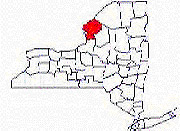|
HISTORY UPDATE
The name of Auburn Prison was changed to Auburn Correctional Facility in 1970 to indicate a change in the philosophy of imprisonment in New York State. The institution continues to be a walled, maximum security prison for male felons, but its plant has been modernized. Actually the present plant is only 67 years old, as all the original buildings have been rebuilt since 1928. Rebuilding was necessary due to the damage caused during the most serious trouble ever experienced at the institution, the riots of July 28th and December 11, 1929. Unruly convicts set fire to the prison shops and destroyed six buildings. Most of the workshops were burned beyond repair. The Legislature funded a major remodeling of the prison in 1930. Reconstruction of the physical plant began in earnest with the removal of the old cell blocks, administration building, kitchen, mess halls and auditorium. New cell blocks were built with stone walls but steel cells. The size of the cells was increased to 61 wide, 81 long and 81 high. Modern plumbing was included. Essentially the same type of construction with interior cells and five tier high galleries was followed inside cell blocks.
Rebuilding continued over a twelve year period after the state purchased 16 acres of land west of the rear prison wall. A modern industrial complex was built on this site to contain the workshops. The new plant housed the cabinet shops, auto license plate shops, cloth shops, bed shop, machine shop and broom and basket shop. Construction of a 351 high cement wall also began in 1930. Over time the original wall has been replaced to add security in the perimeter of the facility. A new school building was added in 1961. It contains 12 vocational shops and 14 classrooms, offices and an assembly room. Today the Osborne School is fully accredited to issue its own diplomas and provides primary and secondary academic programs, high school equivalency program and specialized vocational training programs. In 1971 a new building which houses the media center, gymnasium, library and chapel was erected in the main yard where it is readily accessible to all inmates on a controlled basis. The new visiting room addition to the administration building was opened in 1978 to expand the visiting program for inmates, families and friends. Screens were removed in the new area to permit contact between visitors and inmates. A new health care center was activated in 1987 to provide certain health care services including mental health care services to the inmate population. It contains a small hospital ward, several separate rooms for patients who have mental disorders, private examining rooms, offices for the doctors, nurses and custodial personnel. There has been little change in the statutory basis of correctional industries since the enactment of the State Use Law near the end of the 19th century. At times more restrictions have been passed to suppress any perceived or actual threat of prison labor replacing workers in the private sector. Over the years the work program at Auburn has been self supporting and able to show a profit, largely due to the manufacture of over 3 1/2 million license plates annually for the State Bureau of Motor Vehicles. Other metal and wood products are also produced. Over 350 inmates currently are employed making products such as modular office units under the CorCraft label. Today total civilian staff, including correction officers, teachers, vocational. instructors, industrial supervisors, counselors, medical staff personnel, clerks and administrators, is approximately 860 persons. With double bunking in some housing areas, the total inmate housing capacity is 1,634 persons compared to 1272 accommodations available in 1890. John N. Miskell
|


